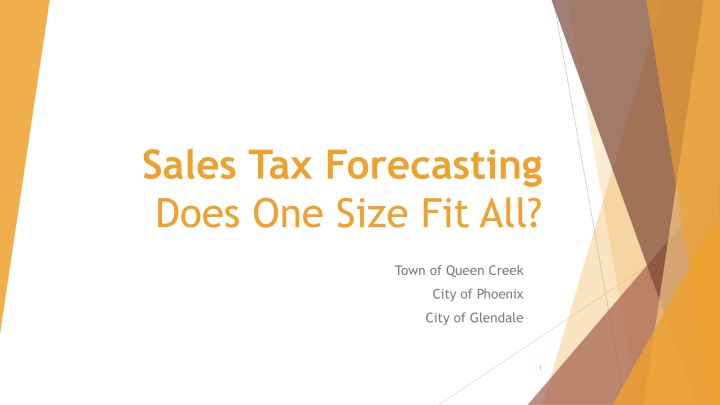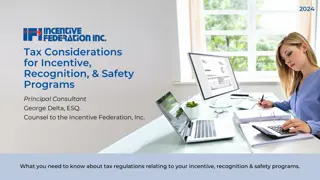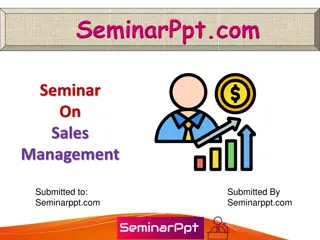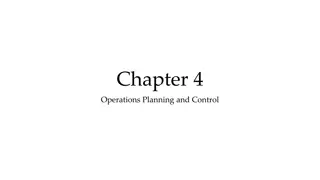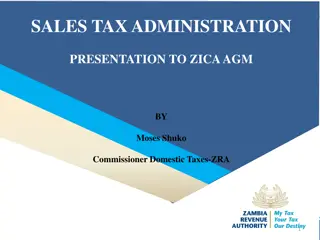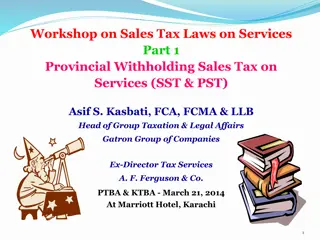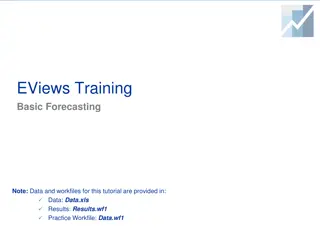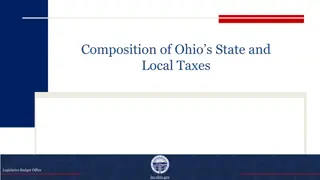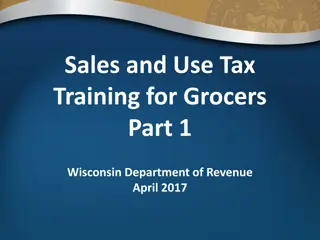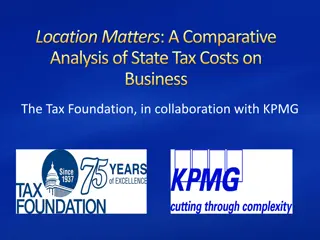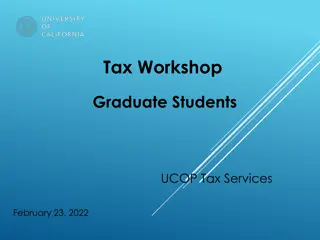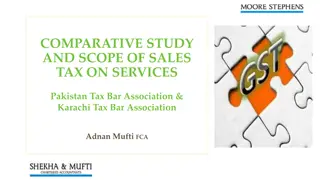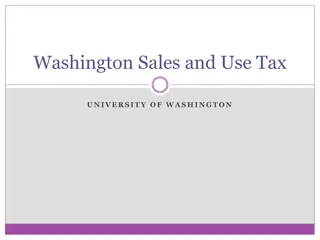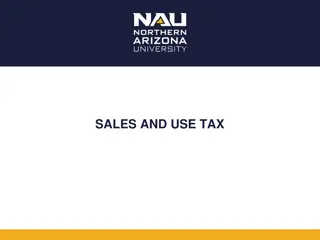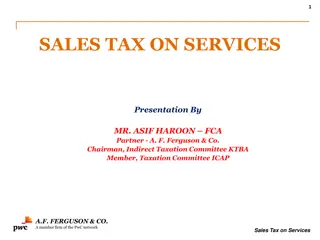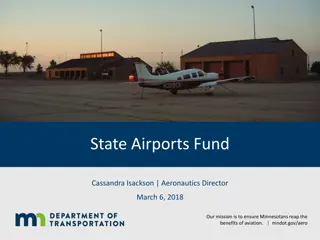Sales Tax Forecasting in Queen Creek: A Deep Dive
This detailed analysis delves into sales tax revenues, demographic information, population projections, and various models, tools, and processes used in understanding the economic landscape of Queen Creek. By examining data sources, tax rates, and forecasting methodologies, this study provides insights into the unique financial dynamics of the town.
Download Presentation

Please find below an Image/Link to download the presentation.
The content on the website is provided AS IS for your information and personal use only. It may not be sold, licensed, or shared on other websites without obtaining consent from the author.If you encounter any issues during the download, it is possible that the publisher has removed the file from their server.
You are allowed to download the files provided on this website for personal or commercial use, subject to the condition that they are used lawfully. All files are the property of their respective owners.
The content on the website is provided AS IS for your information and personal use only. It may not be sold, licensed, or shared on other websites without obtaining consent from the author.
E N D
Presentation Transcript
Sales Tax Forecasting Does One Size Fit All? Town of Queen Creek City of Phoenix City of Glendale 1
Introduction Scott McCarty, Finance Director scott.mccarty@queencreek.org 480-358-3170 3
Sales Tax Revenues in Queen Creek: $29.5M FY19-20 Budgeted Operating Revenues Other Revenues, $14,100,000 , 21% Sales Tax, $24,000,000 , 36% Property Tax, $8,343,000 , 13% State Shared Revenue, $14,781,000 , 22% Construction Sales Tax, $5,500,000 , 8% 4
Data Sources Used in Analysis Demographic Information Population Projections DOR Community and Economic Development departments External analyses RL Brown Housing Data Magic Tool Subscription Joint Legislative Budget Committee City of Phoenix Tax Business Intelligence System 5
Demographic Overview Year Incorporated 1989 Square Miles 39 Town Boundary (Planning Area ~70) Population June 30, 2019 (AZ Office of Economic Opportunity) Median Household Income (2017 ACS 1-Year Supplemental Estimate) Average Household Size (2015 Census) Median Age (2013-2017 ACS* 5-Yr Estimates) Median Value of Housing (2017 ACS 1-Year Supplemental Estimate) 52,405 $96,802 3.49 33.3 years $363,200 6
Population Projections Fast Growing Community Current Population = 54K Buildout Population = 175K 10-Year Projection = 88K (+36K, 70%) 7
Models, Tools, and Processes Sales tax rates FY 19-20 Annual Amount Type of Sales Tax Rate *General Fund 2.00% $26.2M *Public Safety (Dedicated) +0.25% $3.3M Town Center (Dedicated) +0.25% $1.0M Construction Sales Tax (Dedicated) +2.00% $4.9M Total All Purposes $35.4M * FY19-20 Operating Budget $29.5M 8
Models, Tools, and Processes (continued) Studies & Analyses 1. Non-Residential Taxable Retail and Restaurant/Bar Study 2. Potential Impact Fee Credit Analysis (per Impact Fee law) 3. Recessionary Sensitivity Analysis 4. Internal Economic Impact Studies Annexations & Zoning Cases Encanterra Occupied Subdivision Arizona State Lands 9
Models, Tools, and Processes (continued) 1. Non-Residential Spending Study Conclusions (2018 data) 100k+ population in surrounding area (non-residents) Eastmark, Cadence, and San Tan Valley Evaluated taxable retail and restaurant and bar sales in Queen Creek and how much spending is occurring by non-residents Non-residents contributed approximately $5.4 million in sales tax revenue in fiscal year 2018 38% of taxable retail sales and 47% of restaurant and bar sales are estimated to come from non-residents Leakage of spending by Town residents for electronics, autos, furniture, and entertainment 10
Models, Tools, and Processes (continued) 2. Development Fee Credit Analysis Assess potential revenue that may be generated from new development within the Town should that revenue be viewed as a credit against imposed development fees? Conclusions: Receipt of new revenue does not mean it s net new revenue Any revenue generated from new development will be used for operations, maintenance, repair, and replacement of existing facilities New development occurring in the Town will not pay twice for the cost of growth- related facilities 11
Models, Tools, and Processes (continued) 3. Recessionary Sensitivity Analysis & Strategic Planning Sales taxes are largest revenue source how to improve/maintain sales tax growth? Rate comparisons with surrounding communities examine opportunities to prevent leakage Strategies Median forecast and recessionary forecast Zoning Incentives (i.e. auto cap) 12
Economic Analysis of New Construction Strong emphasis on construction sales tax activity & permitting Development Pipeline Planning/Zoning Fees Building Permit Fees Construction Sales Tax Property Taxes Sales Taxes Other Taxes One-Time Revenues Annual Revenues Collaboration with other departments Community Development New development projections Track permits on monthly basis, certificates of occupancy for revenue collections Analyze potential annexations and impacts of zoning changes Economic Development New development economic impact studies 13 Potential commercial development permits and square footage
Sales Tax Analysis Tools Access database developed in-house Monthly DOR sales tax data downloaded to database Easily organize data, run queries, and see trends 14
Monthly Reporting Monthly Reporting Prepare monthly financial report after DOR distribution reports are available Have report completed by end of third business week for prior month activity Sales Tax Appendix in Monthly Financial Report Year-to-date performance vs. current year budget and prior YTD YTD performance by broad sales tax category (construction, retail trade, restaurants & bars, etc.) Construction summary 12-month rolling home closings/completions, monthly closings & average new home sale price by builder Utilize sales tax database to organize data Formatted to easily spot anomalies Historical performance charts 15
Monthly Reporting (continued) Sample of Sales Tax Appendix Charts 12-Month Rolling Actuals $45.0 Millions $42.3 $40.0 $35.0 Total Sales Tax $18.9 $30.0 $25.0 $22.6 Construction Only $20.0 $9.3 $15.0 $23.4 $10.0 Sales Tax Base (Excludes Construction) $13.3 $5.0 $0.0 16
Annual Processes Annual Budget Projections Year-over-year trends for current establishments Estimates for newly permitted commercial establishments Potential economic development updates closings, market concerns impacting larger establishments As of October 2019, the top 10 payers in the retail trade sales tax category accounted for 54% of total retail sales tax collections Review RL Brown housing data to identify trends or market concerns Review Joint Legislative Budget Committee forecasts Revenue adjustments are made in January each year 17
Annual Processes (continued) Contracted Sales Tax Auditing Conduct sales tax audits and follow-ups on trends or irregularities in sales tax collection data Collections from tax audits cover the cost of audits by about 4x In FY18-19, sales tax audit collections represented 1% of total sales tax collections Main audit focus is construction speculative builders Fiscal Years 16-18 Fiscal Year 18-19 Fiscal Year 19-20 (YTD) Total Completed Audits 23 21 4 48 Total Assessments $370K $300K $150K $820K 18
Accuracy The Town is improving its accuracy Most of variance between budget and actual is from construction sales tax Sales Tax Revenues Budget to Actual Adopted Budget (millions) (millions) $29.0 $32.3 Revised Budget Difference (vs. Revised) (millions) $5.9 Difference (vs. Revised) (%) 18% Actuals (millions) $38.2 Fiscal Year 2019 2019 $20.6 22.0 22.1 0.1 <1% (net of construction sales tax) 2018 29.4 30.2 32.8 2.6 9% 2017 25.2 27.9 30.4 2.5 9% 2016 20.8 23.6 24.6 1.0 4% 2015 18.9 18.9 22.2 3.3 17% 2014 13.2 13.2 18.6 5.4 41% 19
Challenges 1. Significant growth Construction activity Annexations 2. Finalize Recessionary Study 3. Numbers are Growing Data Management Time Consuming 4. DOR Data Quality Improve DOR Data Preparation Process/Timeliness 5. Develop a better understanding of Online Impact and Trends 6. Develop internal process to validate payment of sales taxes relating to Town s construction contracts/projects 7. Develop a process to track sales tax revenues relating to Town s utility services 20
Contact Information Scott McCarty, Finance Director scott.mccarty@queencreek.org 480-358-3170 Kristen Stone, Revenue Analyst kristen.stone@queencreek.org 480-358-3177 21
Phoenix 22
City of Phoenix Introductions Sales Tax in Phoenix Sales Tax as a Percentage of Total Revenue Importance of Sales Tax Forecasting Variables for Sales Tax Forecasting Forecasting Methods Accuracy & Challenges Contact Information
Sales Tax in Phoenix Local Sales Tax Stated-Shared Sales Tax: distribute based on jurisdictions population share
Sales Tax as a Percentage of Total Revenue General Fund Only All Funds
Variables for Sales Tax Forecasting Economic indicators Demographic indicators Tax Base Sales Tax Tax Policies Tax Rates Tax Policies
Forecasting Accuracy and Challenges Accuracy Challenges Data Quality/Limited Access to Tax Data
Contact Information Jeff Barton, Budget and Research Director Email: Jeff.Barton@phoenix.gov Tel: (602)262-4800 Dan Wang, Fiscal Manager Email: Danielle.Wang@phoenix.gov Tel: (602)534-1787
Glendale 31
City Sales Tax Sales Tax Rate (2.9%) 7/10 of one (1) cent increase in June 2012 with a 5-year sunset provision Does not apply to single transaction over $5,000 Sunset provision removed in June 2014 Sales tax reviewed annually through the budget process General Fund (1.9%) General government operations Public Safety Parks and recreation Contractual obligations Municipal Property Corporation and Excise Tax debt service 32
City Sales Tax Transportation (0.5%) Voter approved in November 2001 Create and implement a transportation plan Provide regional transit connection Improve traffic flow Reduce air pollution Public Safety (0.5%) Police (2/3) and fire (1/3) services Voter approved original tax rate of 0.1% in March 1994 Voter approved increasing tax rate to 0.5% in November 2007 0.4% increase excludes food for home consumption 33
General Fund Revenue Sales Tax 50% State Shared 30% Misc. 10% Franchise Fees 2% Lic./Fees 3% Development 2% Property Tax 3% Total $235.7 million 34
FY19-20 Debt Service G.O. 24% Water & Sewer 29% M.P.C. 20% Transportation 8% Excise 19% Total $86.9 Million 35
Forecast Methodology Conservative city sales tax growth Averages 2.4% over five-year forecast Slightly higher growth in FY20 and FY21 Moderate State-Shared Revenue increases Consistent with State JLBC Forecast Assumes continued stable statewide economy Accurate in expenditure forecast 36
General Fund Operating Budget Police Services 43% Other 18% Fire Services 22% Development Services 3% Community Services 3% Public Facilities & Events 7% Field Operations 4% Total $221.9 Million 37
General Fund 140,000,000 120,000,000 100,000,000 80,000,000 60,000,000 40,000,000 20,000,000 - FY16 FY17 FY18 FY19 FY20 FY21 FY22 FY23 FY24 FY25 38
Transportation 35,000,000 30,000,000 25,000,000 20,000,000 15,000,000 10,000,000 5,000,000 - FY16 FY17 FY18 FY19 FY20 FY21 FY22 FY23 FY24 FY25 39
Public Safety - Police 25,000,000 20,000,000 15,000,000 10,000,000 5,000,000 - FY16 FY17 FY18 FY19 FY20 FY21 FY22 FY23 FY24 FY25 40
Public Safety - Fire 12,000,000 10,000,000 8,000,000 6,000,000 4,000,000 2,000,000 - FY16 FY17 FY18 FY19 FY20 FY21 FY22 FY23 FY24 FY25 41
Questions? Lisette Camacho City of Glendale Budget and Finance Director lcamacho1@glendaleaz.com 623.930.2492 42
QUESTIONS?? 43
